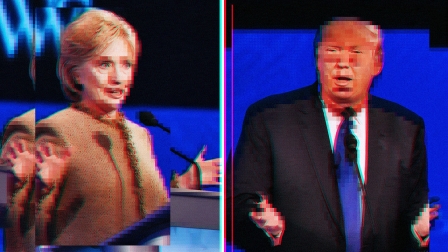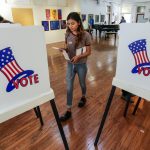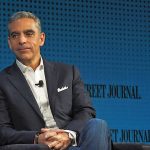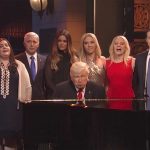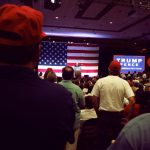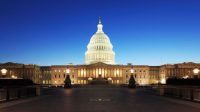How To Make Presidential Debates Better Without Breaking Them
When the first presidential debate of the 2016 general election airs on Monday, we’ll see Hillary Clinton and Donald Trump hew to a tried-and-true method of political discourse: prepared statements, timed responses, and scripted zingers at the ready—all under the strict guidance of experienced moderators. It’s a familiar format, but some say it’s also antiquated and obsolete, and doesn’t really give voters any useful insight into the candidates or their policies. Others say the events of this election present such unprecedented issues that doing things the old way simply won’t cut it anymore.
Lately there have been more calls for a complete reformation of the presidential debate format, but what would that even look like? What changes could the Debate Commission implement that would make the process more interesting, useful, and informative?
The Truth Seekers
David Birdsell, the dean of the School of International Affairs at Baruch College, helped me contextualize the issue. He’s spent decades researching and analyzing political discourse and presidential debates, and says the most bellowed issue thrown at debates is the problem of fact-checking. “[Viewers] always want to hold debaters accountable for the veracity of their statements,” Birdsell says.
The question is, how does one do that?
Before we go any further, it’s important to debunk a few key myths. First, the idea of fact-checking the candidates isn’t new. The question “has existed since the very first debate,” Birdsell says. The other myth is that on-the-spot fact-checking would somehow tighten the effectiveness of a debate. The idea is that if a third party were able to yell from the crowd, “That is not true!” something would change. But the judgment required to know which claims should be called into question would be no easy task. Birdsell pointed to post-debate articles that, line by line, annotate what a politician said. He said this is useful and enlightens the public, but some comments are less valuable to fact-check during the debate than others—especially when occurring during a live taping.
And in the end, it’s not really the moderator’s job or network’s job to ensure all things said are truthful. Historically, says Birdsell, “The person responsible for holding the other party accountable is the candidate.”
Birdsell did offer one potential reform to make things a little cleaner and more interesting—and it might also alleviate some of the fact-checking tensions. “I think it would be great to give the candidates the ability to interrupt the other one or two times during the debate,” he says. It’s like when baseball managers demand replays of close calls. This way, if something truly out of bounds is said and not questioned, the other debater is given the chance to go back and re-analyze it. But this shouldn’t become something oft-utilized. Instead, “It’s a scarce good.”
Citizen Engagement
Beyond candidates questioning each other, perhaps there ought to be better ways for citizens to insert themselves into the conversation. The age-old debate formula is a single commentator or group of commentators asking a series of questions. Before 1992, it used to be a group of media members, all with prepared questions. Then it changed to a single-moderator format, making it less likely for “gotcha” questions to be asked. While the idea behind these formats is that the moderators are unbiased and neutral, more often than not, they don’t have solid methods with which to incorporate citizen sentiment.
A recent paper funded by Civic Hall and the Democracy Fund looked into tools debates around the world were utilizing to facilitate more useful discourse. The research looked at models used in Australia, Taiwan, France, Japan, New Zealand, the U.K., and the U.S. to highlight format changes that have proven either successful or interesting. Constituents from different geographies have different debate presumptions: What a voter in the U.S. may want out of an event is likely different from someone in another country.
At the same time, voters across the world may have similar expectations of these political events, at least at a higher level. A 2010 study from the University of Leeds looked into the “entitlements” voters want from debates; for example, they want to be more a part of the process. Voters, explained Christine Cupaiuolo, a co-author of the new Civic Hall paper, “felt empowered to be part of the democratic process.” Thus her project looked into ways to better make that happen.
Digital Tools
Two of the most prominent ideas put forth in the paper were ways to better involve active engagement with the event. One was an idea implemented by PBS Newshour, which created private Facebook groups for undecided voters to talk about issues before a debate. Then the concerns brought to light in those conversations were used as question fodder for a February Democratic primary debate. This was one example, said Cupaiuolo, that let the public decide the questions. Additionally, such groups can help people digest what the candidates say. Birdsell explained that the Baruch community opens up conference rooms to watch the events together. Then they “turn off the talking heads and talk about it among ourselves.” These groups that engage and reflect on what was seen and heard allow citizens to discuss politics in a polite and civically-engaged way.
Another example of audience engagement was a U.K. debate held in 2015 that utilized a panel of over 100 participants who gave instant feedback about the questions being asked. Each participant had an iPad and rated their sentiments about the topics at hand, which helped the CNN editorial team guide the conversation:
Audience members had eight seconds each time a question came up to select “yes,” “no,” or “no opinion”; a sea of smiling, frowning, and neutral faces would start to appear on the circular wall, reflecting the responses. Drawing on the results, [Christiane] Amanpour would guide the conversation with the panelists and occasionally ask for audience reaction to a point that was made. For these on-the-fly questions, audience members voted thumbs up or thumbs down using their iPads.
Physical Involvement
There are other ways to approach this idea of instant sentimental feedback. Designers at the innovation and design firm IDEO, for instance, have been working with the Sundance Institute on a panel format. Creative Tensions, as the program is called, requires everyone in a room to stand on their feet. Nearby are two speakers and a moderator. On the wall a “spectrum” is presented, which is bookended by polar opposing opinions of a subject. “The entire room—speakers and audience—move in the space along that spectrum,” explained IDEO’s Creative Tensions manager Anna Silverstein, while presenters discuss their opinions. The idea is to get in-the-moment movement that echoes sentiment. For example, if I were in the audience and a speaker said something I disagreed with, I would move away from him or her. So too would everyone else in the room, depending on how they felt. “It forms an interesting conversation that is less political and more nuanced,” says Silverstein.
Creative Tensions was originally devised as a way to make panel discussions more participatory, but its methods have distinct political applications. For instance, a town hall meeting could be facilitated under these parameters by asking participants and candidates to physically move based on how they feel about a subject in the moment. This, explained Hailey Brewer, who leads much of IDEO’s work in the public sector, allows people to explore the nuances of their own views. Where a dry debate feels scripted and reinforces the deadlock of differing opinions, the movement allows people to see if there are moments of agreement. It allows people to “have a real authentic conversation,” says Brewer.
The Bottom Line
Of course, a conversation is really what people want from these debates. These rare events are a way to see a more genuine version of who the candidates are. I asked Birdsell if he saw them as more of a spectacle and less of a debate-and-engage format. “These are much more than spectacles,” he says. Evidence points to viewers watching the events and learning. “Seeing how people respond in these moments teaches you a lot about who they are,” he says.
He added that the gripes being brought up now, while valuable, are not new. People have been complaining about the lack of debate-like flavor since the first one aired in 1960. The only thing different about this election is Donald Trump. He is, says Birdsell, “a candidate who has looked like no other candidate . . . who has a well-earned reputation for making things up. I’m not sure that the remedy for that is to change the debates.”
The answer, then, isn’t to look at the problem created by candidates’ flaws, but figure out a way to bridge the community into the process. “We really need to consider,” says Cupaiuolo, “how we involve people in a way that respects their intelligence and takes seriously their concerns.”
Following that, it’s important to remember why debates exist: For people to see the candidates in a more nuanced and less scripted light. Voters get a chance to watch the politicians think and respond. This serves a function that few other events can. But debates are definitely not perfect—nearly everyone I talked to had some ideas for good and constructive reforms.
All the same, says Birdsell, “they are very valuable.”
Fast Company , Read Full Story
(37)

